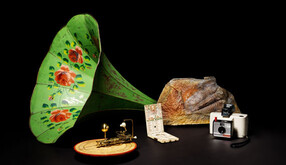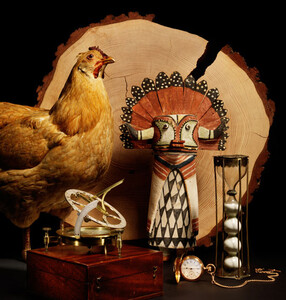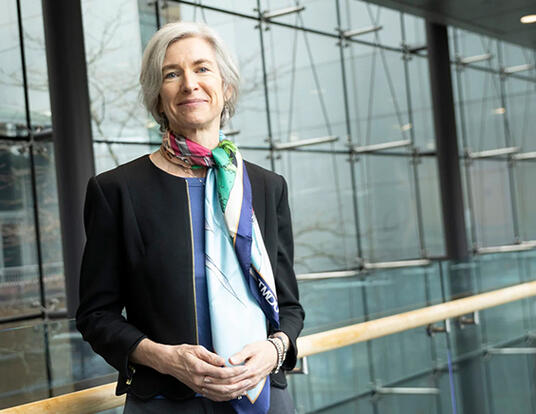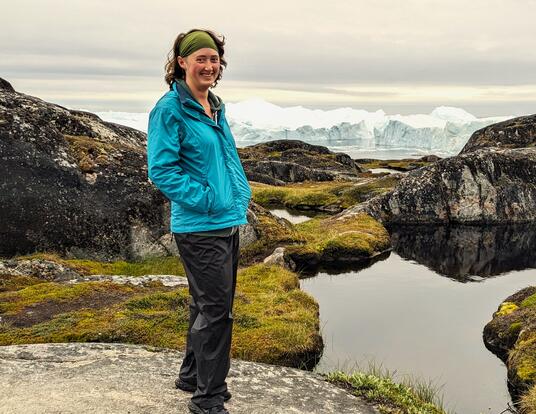Signs of the Time
A Harvard exhibition tracks the human quest to find, keep, manage, and defy our most limited resource
Imagine what it must have been like to live fully in the present, when the ephemera of our lives couldn't be contained on film, or in jpegs, when memories or mundanities couldn't be posted, liked, or preserved for posterity. When posterity as we know it didn't exist. When sounds couldn't be packaged, looped, mashed up, downloaded.

Surrounded by images, just a click away from your first favorite band's first concert in that dive in Athens in '79, it's almost shocking to confront the natural history of time before we captured it—one of the many fascinating points of departure for a new exhibition on time at Harvard's Collection of Historical Scientific Instruments.
For the vast part of our history, experiences happened and then stopped. The scene changed, the image dispersed, the sound faded.
The arrival of the phonograph, the invention of the camera—these tools did more than give us a chance to preserve events and performances, argues this new exploration of how science and culture shape our notions of past, present, and future. They profoundly altered our notions and experience of time itself.
* * *
The materiality of museum objects is grounding, reassuring—time-defying, even when time itself is the theme. Indeed, continuity is one of the narratives that emerges most persuasively from the imaginative, discipline-spanning exhibition assembled by Sara Schechner, PhD '88, the David P. Wheatland Curator at the Collection of Historical Scientific Instruments (CHSI). In its modest gallery space on the second floor of the Harvard Science Center, the exhibition — called Time and Time Again — tells a story as vast as history—and as intimate as your baby's first step.
The exhibit showcases more than 300 objects, drawn from a diverse range of Harvard museums and libraries, that suggest the profundity of time and the inescapability of its limits, while conjuring the ordinary, enduring markers of time's passage—seasons, milestones, rituals, schedules, and lists that have organized our lives for centuries.
The eclectic composition—as Schechner says, it's an exhibit about time with hardly a clock to be seen—is an apt representation of the scholarly aspirations of the people who manage CHSI, which falls under the stewardship of the Department of the History of Science and has become closely tied to that department's teaching and research mission.
Do you think of time as cyclical—as in the chicken and egg conundrum—or linear, like the timer on a stopwatch?
With more than 20,000 objects in its holdings, the collection is among the world's largest such, certainly the largest in North America, says director of administration Jean-François Gauvin, PhD '08. In its willingness to creatively mine its holdings, and to mount exhibitions that draw upon the rich resources of Harvard as a whole, CHSI is the pioneer of a strategy that has lately been embraced by the Faculty of Arts and Sciences, which last year announced the creation of the Harvard Museums of Science and Culture.
This new consortium of six FAS museums has a cumulative holding that exceeds 28 million objects, representing the history, life, and cultures of Earth. Last December, FAS Dean Michael Smith appointed Jane Pickering as the inaugural executive director; she had been deputy director and director of public programs at the Yale Peabody Museum of Natural History and has also played key roles in museums at Oxford and MIT.
The consortium is about "finding new ways to showcase the collections and to exploit the synergies and strengths of the collections," says Gauvin. "This new umbrella organization will tell the story of Harvard's science museums on a much larger scale, promoting all of the collections better than we could do by ourselves."
And yet for at least a decade, CHSI has found success in doing on a small scale what the new consortium hopes to do more broadly. "With history of science being so interdisciplinary, we've often been comfortable mixing it up," says Schechner. "We're very experienced in bringing things from disparate collections and marshaling them together for research purposes or for telling a story in an exhibition." She jokes that some of her borrowing requests yield confusion from her fellow Harvard curators. In one CHSI exhibition, she recalls, "We borrowed from the Harvard Herbaria to tell a story about Ben Franklin. Now, people don't usually think Franklin…seaweed, but he was fascinated with the ocean. His first scientific investigation was during an Atlantic crossing in 1726, when he examined crabs living on sargassum, a seaweed carried north by the Gulf Stream. Forty years later, he would be the first person ever to chart the Gulf Stream. So sargassum was a good place to hang the tale."
It was the same with the new show. As she was reaching out to other campus collections, "they'd say things like, 'Why do you want that belly-button amulet, or the fossil of a trilobite from Braintree? Julia Child's stopwatch—OK, we understand that, it's a stopwatch, but what does a tower of frogs have to do with time, or a mortar and pestle from the Bedouins? Do you really want to borrow all of these things?'
"It wasn't until the exhibition was up that some people who had been scratching their heads finally got it."
CHSI's founding curator, David P. Wheatland, AB '22, would have delighted in these unexpected connections. He knew that the instruments he assembled would tell an extraordinary story about science from the 18th century onward. "When you start reading the stories behind these objects, you see that we have things in this collection that are related to the greatest thinkers in science, from Ben Franklin to Nobel winners—names that are famous through the generations," says Gauvin.
"And they're often related in ways that people don't expect," Schechner adds. "Take William James, for example. People think, William James, philosopher. Well, of course, he was, but in the 1880s he started Harvard's experimental psychology laboratory, and we have instruments from that lab. We can tell the story of why psychology—with its experiments about sensation, perception, and reality—was a science within the philosophy department, until there was a divorce and it achieved its own department in 1934."
The collection can also tell stories about technology transfer among disparate cultures, about economics and trade, about aesthetics and product design, and about local history, spotlighting figures like Thomas Brattle, Edward Holyoke, and John Winthrop, whose names are more familiarly known as geographical markers than as scientific luminaries.
Where does science sit? By paying attention to material objects, or to the social history of science, you can learn a lot about how science is lodged in the larger society.
Wheatland had the insight to see value in objects that others overlooked, and he was able to acquire them for a pittance, relative to their current value. "And he was not just rescuing instruments," says Juan Andres Leon, a history of science PhD candidate who developed a smartphone app called Time Trails that accompanies the exhibit, and who helped set up the collection's online database, searchable from anywhere. "He was also seeing what was happening at Harvard at the time, when Harvard itself was turning from a rather provincial, very good but not globally supreme university, to what it is today. He was part of some of the most important projects happening at Harvard —the Mark 1 computer, the development of radar—and he was collecting things from those projects."
"He had a real knack for understanding what might have research potential later," Schechner adds. "I'm constantly surprised when I look in the collection—Oh, gosh, Mr. Wheatland thought to save this, and to save a series of them. How did he know then that this would be so important later?"
He understood something that also motivates Peter Galison, PhD '83, faculty director of the collection: The value of "the materiality of science" as Galison calls it.
There is no one who more convincingly articulates that value than Galison, Harvard's Pellegrino University Professor, a prolific and boundary-breaking scholar whose work has often been rooted in an exploration of the tangible, the milieu of science and scientists. Now filming a documentary about daily life in a radiation-ruined Fukushima prefecture, Galison has always been curious about "the architecture of the laboratory, the use of space, the forms of evidence, the use of photographs or films as evidence inside the material culture… these provide a way of understanding where science has been, in a very literal sense," he says. "Where does science sit? By paying attention to material objects, or to the social history of science, you can learn a lot about how science is lodged in the larger society. And not purely metaphorically."
Pointing to his 2003 book Einstein's Clocks, Poincaré's Maps, he says he wanted to explore "what it meant that Einstein worked at a patent office for seven years, and took out his own patents and thought about how to evaluate patents he was being paid for. It's trying to take seriously the work of science, and to see ideas and work and materiality as all bound up together."
Historians of science, he says, "are trying to emplace science, to show how it both fits into the wider culture and also alters that culture. And the first stage is to locate it somewhere." Appreciating science as work makes it more accessible—not by popularizing it, but "by showing how embedded it is in practices that you can understand, that are connected to the world. It isn't just a special handshake and a decoder book that ordinary people have no access to."
Galison likes the juxtaposition that arises from "connecting something incredibly tangible or mundane with the deepest, most abstract ideas—and then standing in a space that lets you feel that connection."

That's as good a description as any of what happens as you enter the CHSI gallery and find yourself staring at a chicken and an egg—and a stopwatch. "I wanted people to think about time and the ways in which we interact with it," says Schechner. "So, do you think of time as cyclical (the chicken and egg conundrum) or linear (like the stopwatch timer)—or do you think of it as a combination, like a clock escapement, where the pendulum turns back on itself and yet propels the hands forward?"
The exhibit contrasts Western notions of time, from creation to end times, with Native American notions, where there is no beginning or end. And it explores what Schechner calls deep time, as symbolized by a trilobite fossil slab she borrowed from Harvard's Museum of Comparative Zoology. It was discovered in Braintree, Massachusetts, on Boston's South Shore, a location now best known to many as the last T stop on one branch of the Red Line.
"These creatures were swimming around Braintree some 510 million years ago," Schechner says, "when that was part of the lost continent of Avalonia." As she recounts, Avalonia eventually drifted and joined with other land masses to make the supercontinent of Pangaea. Millions of years later, as Pangaea broke up to form the Americas, Africa, and Europe, "parts of Avalonia got left in Morocco, Scandinavia, and Massachusetts. This fossil creature, this type of trilobite, is only known in those places, where bits of Avalonia remain."
Schechner sees her assembled objects as multivalent, offering perspectives and connections that go far beyond the obvious. By confronting the trilobite away from its natural history context—by viewing it next to a phonograph, a sundial, the manuscript of a Bach fugue, a domestic calendar, and a baby journal—we can ask ourselves new questions about how these objects help to ground us, offering some sense of permanence over the vastness of time.
Time and Time Again
Snapshots from the exhibition
Time as Ritual
In the late 19th and early 20th centuries, when a Lakota baby was born, a female relative would make an amulet to hold the umbilical cord—turtle-shaped for girls, lizards for boys. Children wore the amulets around their necks, as a rite of passage, up until they were about 6.
Peabody Museum of Archaeology and Ethnology, Harvard University. Photograph by Samantha van Gerbig/Collection of Historical Scientific Instruments.
Time in a Series
The exhibition suggests that time can be experienced and measured as a forward progression through a series—of developing frogs or of oil lamps from the Early Bronze Age through the modern period.
Frog development series, Rana esculenta, Museum of Comparative Zoology, Harvard University; oil lamps, Semitic Museum, Harvard University. Photograph by Samantha van Gerbig/Collection of Historical Scientific Instruments.
Time Flows
"Universal History Illustrated: or the Stream of Time, made Visible," a time chart by Samuel G. Goodrich, New York, 1841. Harvard Map Collection.
The Business of Time
Greater Boston was home to two important clockmakers, William Bond & Son, a maker of chronometers and precision clocks, and the American Watch Company of Waltham, which revolutionized the way watches were made. "Their watches were so good—they were not only most precise, they were less expensive—that the Swiss actually counterfeited them," Sara Schechner says. "What goes around comes around." Collection of Historical Scientific Instruments
Work Time
The constructs that govern our working lives—the 8-hour workday, the weekend, even the 24-hour day itself—are mostly arbitrary. The length of our day derives from the ancient Egyptian administrative structure, Schechner explains, which split the year into 10-day weeks, with a new bright star rising at the start of each 10-day period. At any given time there were 12 such stars in the sky, which led to the night being divided into 12 hours. Days were similarly divided, for parity. (The division of hours and minutes into increments of 60 came from Babylonians, whose system of mathematics was built on base 60.)
Time Tracking, Together in Time
Derrah's Official Street Railway Guide for New England, Boston, circa 1907. Like all timetables, this one helps people synchronize their movements and stay on time. Baker Library Historical Collections, Harvard Business School.
End of Time
The exhibit closes with evocations of death, including a display of W. H. Auden's Funeral Blues. The first stanza:
Stop all the clocks, cut off the telephone,
Prevent the dog from barking with a juicy bone,
Silence the pianos and with muffled drum
Bring out the coffin, let the mourners come.
Image credits:
Top:
Objects from the exhibition Time and Time Again, at the Harvard Collection of Historical Scientific Instruments: Flowered phonograph horn [Edison Manufacturing Company, New York, c. 1904]; portable orrery [Peter & John Dollond, London, ca. 1787]; ivory diptych sundial [Joseph Ducher, Nuremberg, 1640-1644]; Paradoxides Acadoparadoxieds harlani (trilobite) [Braintree, Massachusetts, Museum of Comparative Zoology, Harvard University]; and “Swinger” instant camera belonging to Edwin Land. All Collection of Historical Scientific Instruments, Harvard University, except as noted.
Bottom:
Objects from the exhibition Time and Time Again, at the Harvard Collection of Historical Scientific Instruments, as assembled in front of a cross section of Eastern hemlock [Arnold Arboretum, Boston, 2012, Harvard University Herbaria]: From left: Gallus domesticus [Museum of Comparative Zoology, Harvard University]; inclining sundial with case [Matthew Berge, London, ca. 1810, Collection of Historical Scientific Instruments]; Si’o Sa´lako Katsina [Hopi, Arizona, pre-1892, Peabody Museum of Archaeology and Ethnology, Harvard University]; hunting case pocket watch with chain and fob [Edouard Richard, Le Locle, Switzerland, ca. 1885, Collection of Historical Scientific Instruments]; and sand glass with fractionated ampoule [French, mid-18th century, Collection of Historical Scientific Instruments].
Get the Latest Updates
Join Our Newsletter
Subscribe to Colloquy Podcast
Simplecast Stitcher




